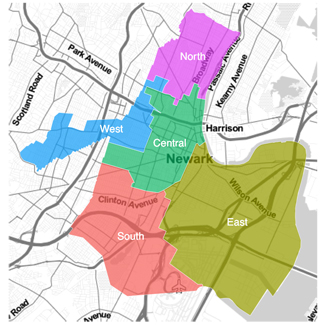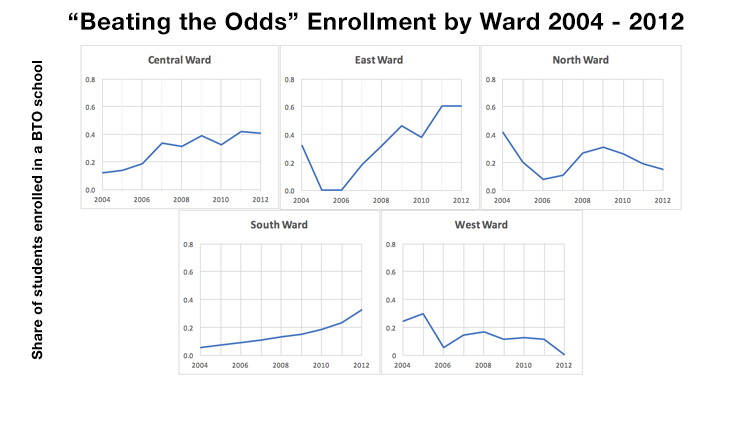After more than two decades of state supervision, Newark’s public schools are slated to return to local control. When the state hands the keys back to the city, local leaders will inherit a district that’s in a fundamentally different position than it was in 1995, the year the state took over.
Back in 1995, Newark Public Schools (NPS) ran all of the city’s schools. The first charter school in Newark wouldn’t open until 1997. But today, charter schools enroll about 30 percent of Newark’s students citywide, making Newark one of the nation’s several “high-choice” cities: places where charter schools are in the mainstream, not on the margin.
When Newark’s local leaders regain control of the district, they can’t ignore this new reality. They can’t just focus on improving NPS, they must also think about how NPS and the city’s surging charter sector interact and find ways to ensure that Newark’s high-choice system promotes educational opportunity and equity citywide.
That’s one of the key messages from the Newark Education Success Board (NESB), a task force created by Governor Chris Christie and Newark Mayor Ras Baraka. Back in August 2016, the NESB released a report outlining the path toward local control in Newark. Understandably, the report included hundreds of recommendations for improving NPS (covering everything from governance, instructional programs, and talent development, to parent and community relations and the district’s finances). But the report also pointed out that NPS can’t go it alone.
“Students and families are best served,” the report said, “when the different sectors [district and charter] communicate and share resources to ensure that all schools in Newark are delivering the highest quality education for all children.” With that in mind, the NESB called for a new “NPS/Charter/Faith-based Working Group” that would formalize district-charter communication routines and create a forum for addressing a host of issues, such as developing a “set of shared values and indicators of success” for the entire city and advocating for “innovations in policy and practice.”
The good news is that Newark has a head start on that kind of crossover collaboration. The city already has a common enrollment system that makes applying to charter and district schools less complicated for parents. Most of Newark’s charter schools have already signed a compact that commits them to greater transparency, accountability, excellence, and equity to support improvement citywide.
But the key challenge for Newark when it regains local control—and the key challenge for all cities, regardless of the makeup of their school system—will be improving school quality across its diverse system of schools. There just aren’t enough good schools to go around, charter or district. And too often, good schools are clustered in some neighborhoods and not in others.
Consider a quick example: much has been made of the finding that Newark had one of the highest rates of “beating the odds” enrollments among the 50 cities we covered in our 2015 Measuring Up report. Compared to a 50-city average of 8 percent, Newark enrolled almost a third of its students in schools that outperformed similar schools elsewhere in New Jersey.
That’s a positive report for Newark. But those citywide results don’t tell the whole story. When we looked at the share of “beating the odds” enrollments within Newark’s five wards, it appears that some areas of the city do better than others. “Beating the odds” enrollments appeared to grow in the East, Central, and South wards between 2006 and 2012, and decline in the West and North Wards over the same period.
It’s worth noting that the decline shown in the West Ward may be overstated because of the way New Jersey reports data on two of Newark’s high-performing charter school networks (it provides these network results in a single record, rather than breaking them out campus by campus). We assigned the results from these two charter school networks to the wards where the majority of their schools are located. That means that the West Ward does not include two schools that could improve its results: Vailsburg Elementary and Alexander Street Elementary. We may have underestimated the positive results in the South Ward for the same reasons. Unfortunately, we were not able to obtain campus-level results to gauge how much these data issues affect this characterization.
That caveat notwithstanding, the bigger point is that intra-city differences like these can have important implications for equity and opportunity depending on a city’s demographics. In Newark, for example, African Americans mostly live in the West, Central, and South wards; the North Ward is majority Hispanic; household incomes are lowest in the Central and South wards.
 So, in addition to calls for collaboration and communication, leaders in Newark now need to ask themselves, “How will we and our partners in the charter sector improve the overall supply of schools—district and charter—in ways that offer viable options for all families and neighborhoods?”
So, in addition to calls for collaboration and communication, leaders in Newark now need to ask themselves, “How will we and our partners in the charter sector improve the overall supply of schools—district and charter—in ways that offer viable options for all families and neighborhoods?”
While there’s no one best way to answer that question, a fragmented approach isn’t likely to work. Parallel play reform strategies—expand the charter sector on the one hand and try to reform the district from within on the other hand—may work when charter schools are only a small share of the system. But when charter schools make up 30 percent of a system they can introduce cross-cutting issues that arguably require a more holistic approach. As the NESB recommends, the city needs to pursue agreements and policies that support a shared responsibility between the sectors for improving schooling citywide, even as NPS works on the many internal improvements it surely needs to make.
D.C., provides an instructive example: a strong charter authorizer and school district operate with mutual awareness and a set of shared agreements (for example, around information, enrollment, etc.). Our CRPE colleagues Paul Hill and Ashley Jochim have proposed a more radical solution: a new institution (a community board) that would oversee all public schools and get the school district out of the business of oversight (the district would become a school operator, much like a charter management organization).
Current Newark Superintendent Chris Cerf often says that he wants Newark to rise above the district-charter distinction. “I would very much like to get everybody out of the box of public schools versus charters,” he said. What matters instead is whether a school is “a great, free public school and whether parents have an equal opportunity to access them.” Given the history of political conflict in the city, that’s a lofty goal. But it’s also worth embracing because it recognizes that Newark’s public schools today are a far cry from where they were the last time local leaders were in charge.
— Michael DeArmond and Patrick Denice
Michael DeArmond is senior research analyst at the Center on Reinventing Public Education. Patrick Denice is a postdoctoral research associate at Washington University in St. Louis.
This post originally appeared on The Lens.



